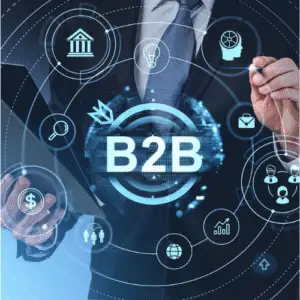
Key Takeaways
- Link automation strategies directly to revenue and growth goals.
- Simplify capture, nurturing, and scoring for measurable outcomes.
- Ensure compliance with privacy laws like California’s opt-out rule.
- Unify CRM and automation for faster handoffs and cleaner data.
- Continuously measure and refine automation for better results.
A strong B2B marketing automation strategy gives structure to complexity. Modern B2B organizations thrive when their marketing automation programs connect every system, process, and message directly to measurable growth. Without a defined strategy, automation becomes noise; with it, it becomes a bridge between marketing intent and revenue impact. As customer journeys evolve and privacy laws tighten, an intelligent B2B marketing automation strategy ensures efficiency, trust, and sustainable performance.
How Does a Strong Strategy Transform B2B Marketing Automation?
An automation platform is only as powerful as the strategy that guides it. Many B2B teams rush to implement tools, but few pause to align them with real business objectives. A cohesive B2B marketing automation strategy ensures that technology serves defined goals; lead generation, revenue acceleration, and compliance, not the other way around. When workflows are connected by purpose, every campaign moves the buyer closer to conversion while protecting data integrity.
This strategic layer leads directly to scalable benefits: marketers can track engagement in real time, score leads consistently, and automate compliance processes without overwhelming internal teams. A connected system does not just act faster; it acts smarter, enabling seamless collaboration between marketing and sales.
How Can Businesses Align Automation with Growth Objectives?
To make automation purposeful, it must mirror business priorities. Begin by mapping each automation process to a quantifiable objective, whether it’s boosting lead quality, reducing handoff delays, or increasing deal velocity. These measurable touchpoints create accountability across departments.
Once aligned, collaboration becomes natural. Shared dashboards between marketing and sales eliminate silos, ensuring teams chase the same metrics; qualified opportunities, revenue per campaign, or meeting-to-close ratios. This mutual visibility transforms automation from a series of technical routines into a shared revenue engine that strengthens the overall B2B marketing automation strategy.
What Platforms and Processes Build a Scalable Foundation?
Oracle Eloqua, Adobe Marketo, or HubSpot, etc. forms the foundation of scalability. Each must integrate cleanly with CRM, analytics, and data governance in marketing layers. But beyond platform, success depends on the discipline of workflows: how leads are captured, scored, nurtured, and routed.
A unified system enforces consistency. Automated scoring prioritizes prospects intelligently, while dynamic nurture tracks deliver personalized content at the right stage. Segmentation, informed by firmographics and behavior, keeps outreach relevant. This blend of precision and personalization strengthens B2B lead nurturing, accelerates pipeline velocity, and supports marketing-sales alignment within a broader B2B marketing automation strategy.
What Integration Challenges Should Marketers Prepare For?
Even the best architecture falters without integration. Disconnected systems lead to duplicate data, missed follow-ups, and incomplete reporting. Solving these requires proactive design:
- Validate field mappings and IDs across platforms.
- Synchronize data in near real time.
- Train teams to trust automated alerts and routing.
When automation and CRM share a single data truth, efficiency compounds. Insights sharpen, handoffs accelerate, and teams spend more time on strategy. Integration thus becomes the invisible backbone of every effective B2B marketing automation strategy.
How Do Data, Personalization, and Privacy Work Together?
Strong data governance in marketing ensures compliance without limiting creativity. Automate consent management, honor Global Privacy Control compliance standards, and embed deletion workflows for expired records. When compliance is coded into automation, marketers gain freedom to focus on meaningful engagement rather than risk mitigation.
Integration unlocks richer personalization, but personalization demands responsibility. As regulations like GDPR and CCPA evolve and with California’s new in-browser opt-out signal becoming, law marketers must design systems that adapt to shifting privacy expectations. In mature programs, data privacy and personalization reinforce each other, building trust within a robust B2B marketing automation strategy.
Which Emerging Technologies Are Redefining B2B Automation?
Artificial intelligence, middleware, and cloud-based analytics now amplify automation’s impact. AI-assisted scoring, predictive content recommendations, and cross-platform attribution enable teams to anticipate intent, not just react to it. Middleware solutions connect fragmented ecosystems, ensuring clean data flows from form fill to closed deal. When these technologies operate together, marketers can prove revenue contribution with precision and scale their B2B marketing automation strategy confidently.
How Can B2B Teams Measure and Optimize Automation Effectively?
Measurement ties every section of this journey together. Continuous optimization is the feedback loop that validates every automation decision. Core metrics like lead-to-opportunity conversion, pipeline velocity, and campaign ROI reveal where value is being created and where refinement is needed. By embedding these KPIs into automated dashboards, B2B teams ensure that every decision remains data-driven and that their B2B marketing automation strategy evolves through evidence, not assumption.
Conclusion
True B2B marketing automation strategy thrives when technology, compliance, and collaboration unite under clear business goals. When systems and teams align, marketing automation for B2B delivers stronger lead nurturing, faster conversions, and transparent reporting. A unified approach rooted in consent management and data governance in marketing builds both growth and trust. If your organization is ready to connect automation strategy with measurable impact, 4Thought Marketing can help design a roadmap that balances compliance, innovation, and scalability. Let’s transform your B2B marketing automation strategy into a sustainable driver of performance and trust.
Frequently Asked Questions (FAQs)
1. How do we choose the right marketing automation platform for B2B?
Start by defining business outcomes—lead scoring, data visibility, or compliance—then assess integration depth with CRM, reporting flexibility, and scalability. Pilot first to test usability and fit.
2. What’s the best way to align automation projects with sales objectives?
Co-create success metrics with sales, such as opportunity creation or meeting conversion. Shared dashboards and unified definitions prevent misalignment and keep both teams focused on pipeline impact.
3. How can we ensure seamless integration across systems?
Standardize field mappings, IDs, and sync intervals. Use middleware or APIs to connect Eloqua, Marketo, and CRM tools. Regularly test for duplicate records and data lag to maintain reporting accuracy.
4. How do we balance personalization with privacy compliance?
Automate consent tracking and honor Global Privacy Control signals. Personalize messaging using compliant data attributes—industry, role, engagement—without collecting unnecessary personal information.
5. What metrics best demonstrate automation ROI?
Track lead-to-opportunity conversion, campaign-influenced revenue, and pipeline velocity. Use comparative A/B testing to see which automations shorten sales cycles or improve deal quality.
6. When should we involve a marketing automation consulting partner?
Bring in experts when scaling to new markets, integrating multiple systems, or addressing complex privacy frameworks. They help build scalable architecture and ensure compliance without slowing execution.





